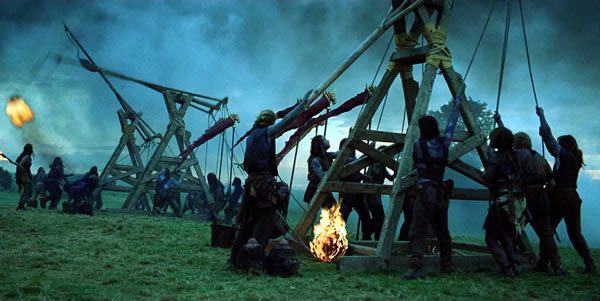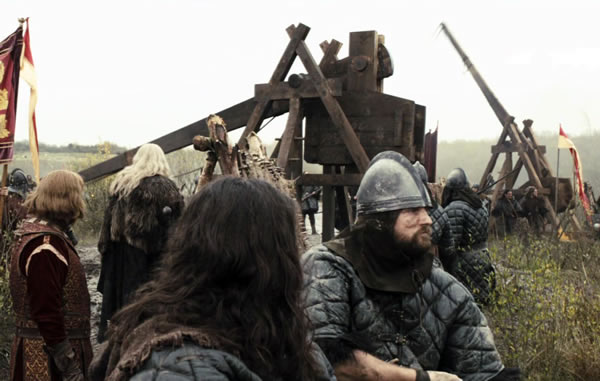In Remaking the Middle Ages (2011), Andrew B. R. Elliott coined the term “historicon” to identify a film’s “visual conventions which each aim to evoke to the spectator an element of ‘medievality.’” ((Andrew B. R. Elliott, Remaking the Middles Ages: The Methods of Cinema and History in Portraying the Medieval World (Jefferson: McFarland, 2011), 182.)) He provides numerous examples including knights, castles, and princesses, but obviously there are so many more. ((Elliott, Remaking the Middle Ages, 193.))
A moviegoer can see these historicons and immediately associate the film with the medieval world. These are not always historically accurate. In fact, many of these historicons are anachronisms (e.g., William Wallace in a kilt) or pure inventions (e.g., ball-and-chain) that popular culture has come to accept as “medieval.”
The (in)accuracy of these historicons should not shock anyone, as historians have emphasized that in cinematic medievalism, audiences will accept was feels authentic well before they accept the “historically accurate.” ((This is a point made over and over again, but some examples include Bettina Bildhauer, “Medievalism and Cinema,” in The Cambridge Companion to Medievalism, ed. Louise D’Arcens (Cambridge: Cambridge University Press, 2016), 49; Elliott, Remaking the Middle Ages, 215. Margitta Rouse has synthesized the conflicting theories on the topic in Margitta Rouse, “Rethinking Anachronism for Medieval Film in Richard Donner’s Timeline,” in The Medieval Motion Picture: The Politics of Adaptation, eds. Andrew James Johnston, Margitta Rouse, and Philipp Hinz (New York: Palgrave Macmillan, 2014), 61-64.)) Thus, it becomes a much more worthwhile exercise to understand filmmakers’ decisions about historicons and how the audience accepts them.
In terms of what historicon can evoke medievalism most effectively, Bettina Bildhauer believes
nothing epitomizes the Middle Ages more than the cathedral: a profoundly anti-modern, pre-Enlightenment, pre-Rationalism space, where time stands still in an eternal visual splendour appreciated by a community of believers. ((Bettina Bildhauer, “Medievalism and Cinema,” 58.))
While the cathedral is a fine choice for such a crown, allow me to tear it down with the trebuchet.
The traction trebuchet (below), operated by men pulling ropes on one end, was invented in China as early as the 3rd-century. It made its way through the Islamic, Byzantine, and European worlds during the 6th- and 7th-centuries. ((Paul E. Chevedden, et. al. “The Traction Trebuchet: A Triumph of Four Civilizations,” Viator 31 (2000): 437-439.))
Arabic and Armenian medieval documents provide large figures of rope pullers ranging from 400-600 men, ((Chevedden, “The Traction Trebuchet: A Triumph of Four Civilizations,” 443.)) but Hollywood has portrayed smaller machines of a handful of operators.

The Islamic, Byzantine, and European worlds utilized and evolved the traction trebuchet into the fixed-counterweight trebuchet and the hinged-counterweight trebuchet (below) until it fell out of use by the 15th-century due to the rise of gunpowder.

What is remarkable about medieval weapons and armor in museums today is that most of them came after the medieval period. One armor specialist estimates “practically ninety-nine percent of existing armor dates from after A.D. 1500.” ((Helmut Nickel, “Arms and Armor in Arthurian Films,” In Cinema Arthuriana: Twenty Essays, ed. by Kevin J. Harty (Jefferson: McFarland, 2002), 236.)) Similarly, no original trebuchets exist today. ((For a discussion on the problems of evidence, see Peter Purton, A History of the Early Medieval Siege, c.450-1200 (Woodbridge: The Boydell Press, 1999), 360.)) This is due to the simple fact that trebuchets were built sieges and then deconstructed for transport or material elsewhere. There was simply no reason to keep a trebuchet around once it had served its purpose. That is remarkable for a weapon that was in use from as early as the 3rd-century to the late-15th-century, a machine that historian Paul E. Chevedden correctly claims “dominated warfare far longer than any other form of artillery.” ((Chevedden, “The Traction Trebuchet: A Triumph of Four Civilizations,” 433.))
Conversely, cathedrals did not rise to prominence until the early-4th-century and many still stand today. Cathedrals also lack the culture diffusion and evolution of the trebuchet, as they touched the European and Byzantine worlds, but obviously not the Islamic and Chinese worlds, except those converted to mosques. Quite simply, the trebuchet remains confined entirely to the Medieval period for its existence and it spread across a much larger swath of the world during its existence, making it much more quintessentially medieval than the cathedral.
In terms of the trebuchet as a film’s historicon, it excudes pre-modern, even if the filmgoer has no clue what they’re looking at. Watching it in action, the machine’s use of gravity will appear both simplistic and premodern, lacking the obvious use of gunpowder. Thus, when filmmakers forgo the use of gunpowder in favor of the trebuchet in a medieval film such as The Messenger (1999), we should not be surprised. The filmmaker is simply striving to present a historicon that the audience will accept as authentic.
